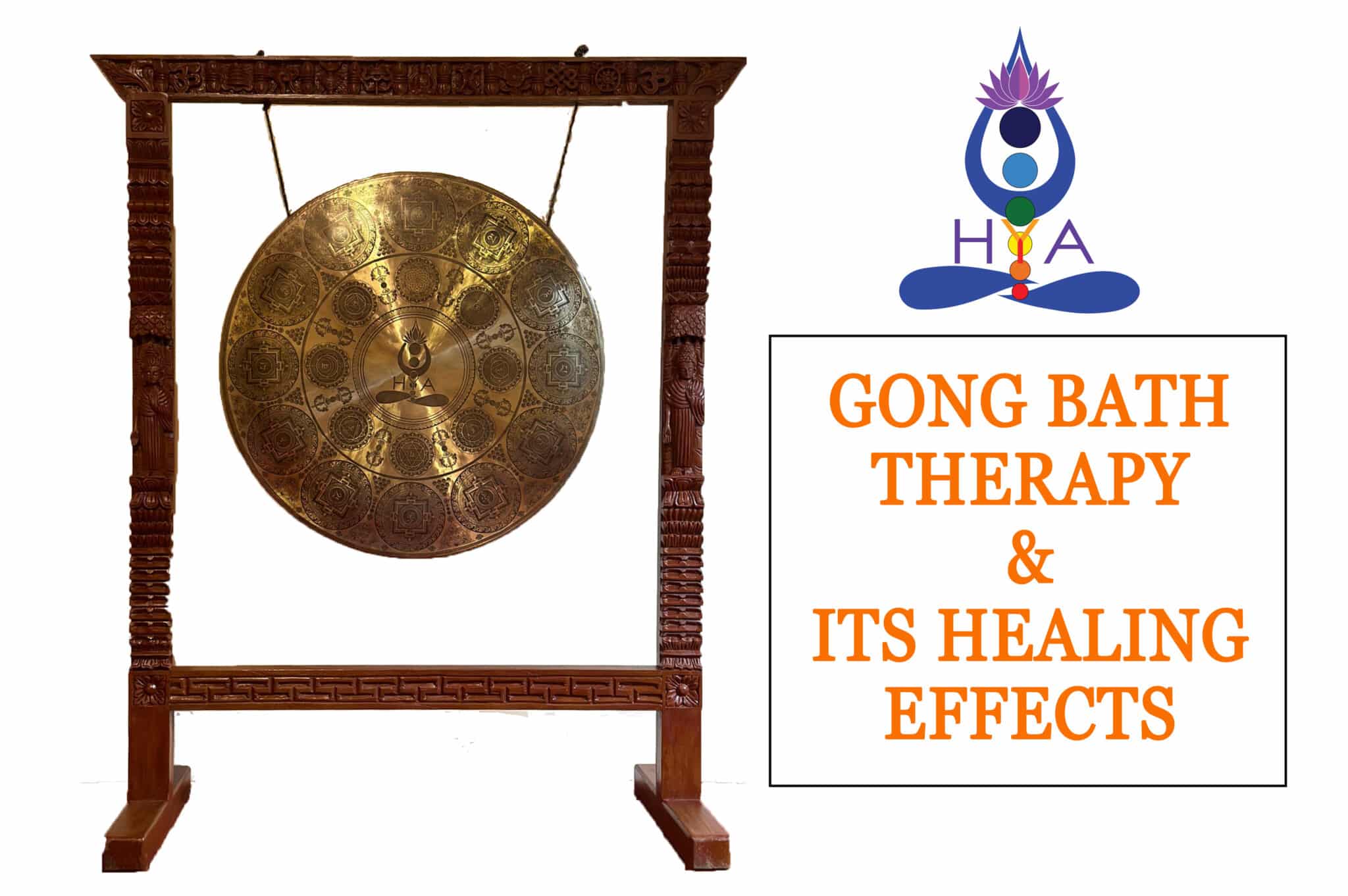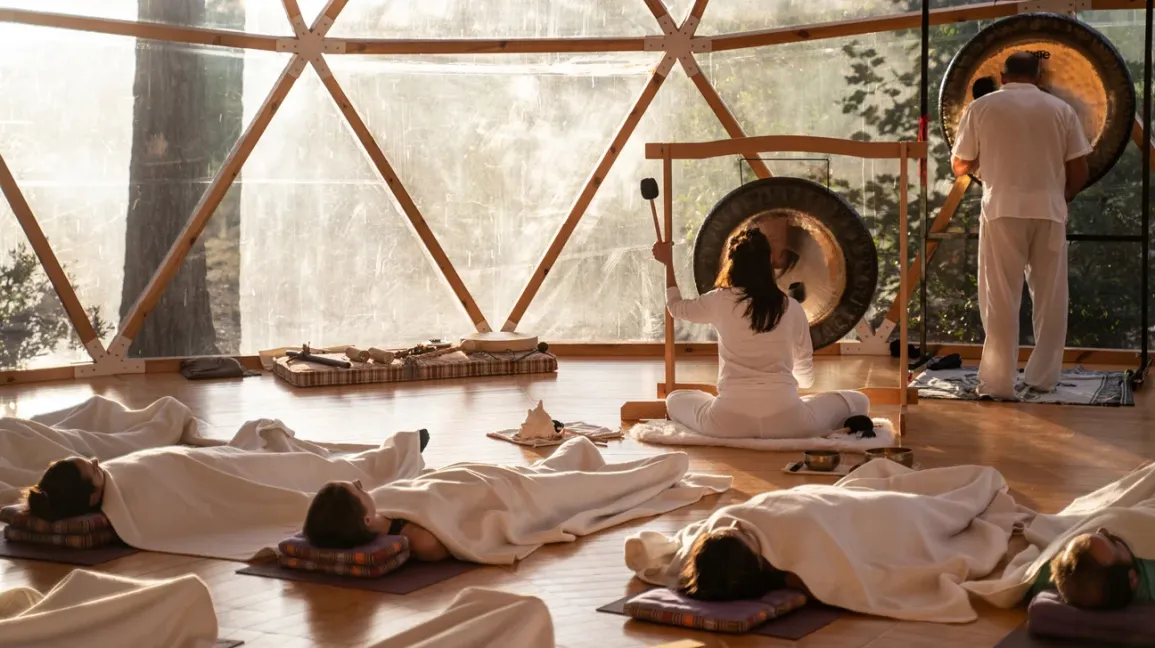
7 May 2024 HYN Himalayan Yoga Academy
What is Gong Bath Therapy? Gong sound healing has been practiced for thousands of years, with its history dating back to ancient cultures. The gong is an instrument made from brass or bronze, producing a wide range of frequencies, tones, and harmonies.
What people often don’t know: As far as different sounds are concerned; they are distinct and different. But gong is generally underestimated. When people think of the sound of a gong, they usually only think of a small sound. But the sound and frequency of a gong depends largely on where you place the hammer and which gong hammer you use. The shape, form, and type of gong also play a role in its sound. We want to show you what gong sounds and gong sounds are available, what is possible, and how gong music can improve your daily life.
What is Gongs?
The gong is a round disc made of copper and tin, and when struck with a hammer it produces a loud sound, which sounds very pleasing to the ear in this world. Gongs have been used throughout history for a variety of purposes, including meditation, rituals, spiritual development, and even funeral ceremonies. Different gongs come in different sizes and shapes, and each has its unique sound.
The History of Gongs
Gongs have originated in Tibet since the 6th century AD and have spread to countries such as China, Vietnam, Burma, and Indonesia. These regions were known to produce some of the finest gongs of the ancient world. Making gongs was not easy as it required extraordinary skill and craftsmanship. In ancient China, only certain clans could make gongs, and the best ones were made of copper. The process is very unique and consists of five stages: casting, hammering, softening, refining, and grinding. All these steps were very important for this to produce a good and clear sound.
What is a Gong Bath?
Gong Bath is a form of meditative healing practice in which participants lie or sit comfortably while surrounded by the vibrations of gongs, singing bowls, bells, cymbals, and many other musical instruments. The goal is to promote relaxation, stress reduction, and healing through the power of sound. Gong bathing began as a spiritual and religious ritual but has now become a popular form of group therapy and one-on-one sound healing. These sessions often take place at yoga studios or state retreats and can be experienced in person, online, or by listening to a pre-recorded gong float on YouTube. Gong Bath Therapy offers the opportunity to escape the distractions of daily life and connect with the inner world through the power of sound.
How Does Gong Healing Work?
During this sound bath, participants sit or recline close to the gong and other sound-healing instruments played by the therapist. The sound waves generated by the gongs and other instruments interact with the body, causing physical and mental relaxation and helping to restore balance and harmony in the mind, body, and spirit. Studies have shown that the frequencies produced by the gong can slow down the mind and bring it into a deeper, slower state of vibration. This can help reduce stress, improve sleep quality, and promote overall well-being.

Benefits of Gong Healing Therapy
1) REJUVENATES THE BODY ENERGY & MIND
Gong bath deeply stimulates the body and creates a feeling of deep relaxation. When we are free and the chatter in our minds is quieted, we can sleep peacefully and undisturbed.
2) THEY BRING DOWN LEVEL OF STRESS
Stress is not good for us, it’s that simple. Although it is not possible to eliminate stress, we can take steps to reduce it. The deep sense of relaxation that a sound bath can create makes our body and mind feel less stressed. Stress is linked to many diseases, including high blood pressure, dementia, headaches, and heart disease. The more we can do to reduce stress in our lives, the healthier we will be.
3) TACKLES OBESITY
Stress causes the release of more cortisol hormones in our bodies. These specific hormones increase fat stored in the abdominal area. Excess belly fat appears to be more damaging to our health than fat stored in the thighs and legs. Therefore, stress can be associated with obesity, a condition that causes excessive stress on the body. Obesity can also lead to life-threatening diseases such as diabetes and heart disease.
4) REDUCES ANXIETY AND DEPRESSION
Such baths can reduce stress and anxiety and increase blood pressure. This helps lower blood pressure and improve our overall mood. When we feel calm and happy, our mood improves, stress decreases, and we can sleep better. Poor sleep is a major cause of feelings of anxiety and depression.
5) BALANCES THE NERVOUS SYSTEM
The soothing sounds and vibrations provided by the gong bath and the relaxing state it puts us in help activate the parasympathetic system. This also makes the system more sensitive to the back seat. Simply put, the parasympathetic system dominates the calm ‘rest and digest’ zone, while the sympathetic system initiates ‘fight or flight’ in stressful situations.
More Benefits of Gong Bath
- Relax and reduce stress
- Eliminate energy blockages
- Reduce pain caused by inflammation
- Improve sleep quality, mental health, emotional health, and spiritual well-being.
Preparing For A Gong Sound Healing Session
When preparing for a healing gong sound session, it is important to consider the following factors to ensure the best experience:
- Choose a song that resonates with you and produces a rich, resonant sound.
- Choose an environment that is comfortable, quiet, and free of distractions.
- Maintain an even and unobstructed distance.
Tips for creating a comfortable and relaxing ambiance:
- Wear comfortable clothing, such as loose-fitting clothes or yoga clothes.
- Eat well and avoid large meals before the session.
- Set a schedule for your daily activities so you can rest in between.
- Set a learning goal, focus on your personal goals and aid recovery.
- Bring warm layers, socks, and towels to keep you comfortable during class.
Guidance on Appropriate Setup and Attire:
- Lie down on a comfortable surface such as a yoga mat or towel.
- Use a pillow or extra pillow under your knees and a pillow or blanket under your head for support.
- Consider using an eye pillow or towel to protect and rest your eyes.
- If you have difficulty lying down, inform the practitioner, bring an extra pillow, or ask for a chair.
